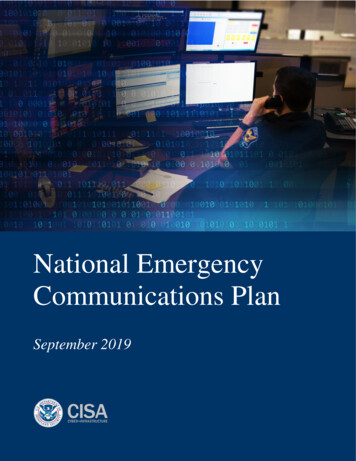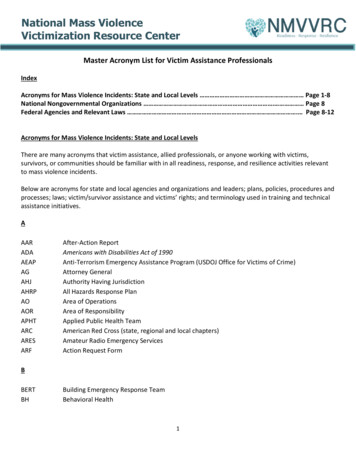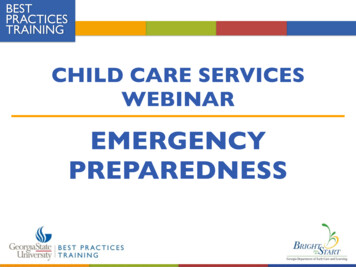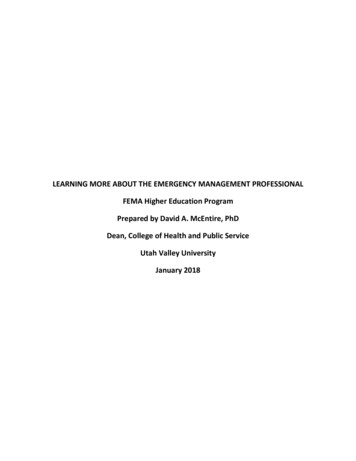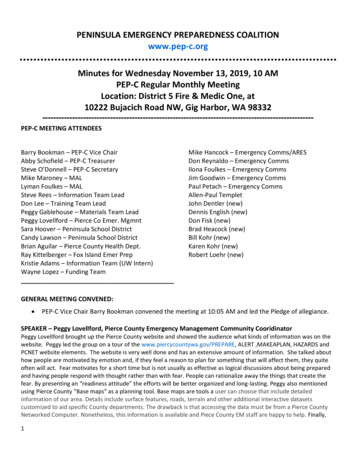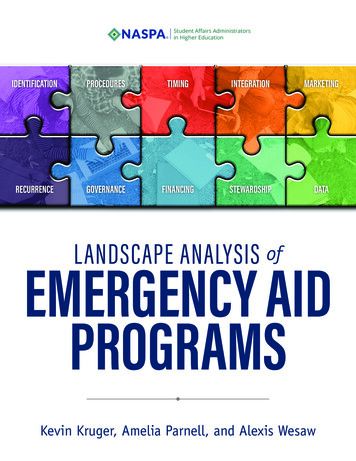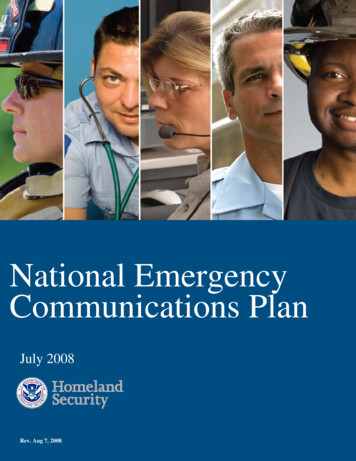
Transcription
National Emergency Communications PlanJuly 2008NationalNational PlanNational EmergencyCommunicationsPlanJuly 2008PRELIMINARY DRAFT v1.02PRELIMINARY DRAFT v1.02Rev. Aug 7, 2008
National Emergency Communications PlanJuly 2008Message from the SecretaryNumerous after-action reports from major incidents throughout the history of emergencymanagement in our Nation have cited communication difficulties among the manyresponding agencies as a major failing and challenge to policymakers. Congress and theAdministration have recognized that successful response to a future major incidenteither a terrorist attack or natural disaster-would require a coordinated, "interoperable"response by the Nation's public safety, public health, and emergency managementcommunity, both public and private, at the Federal, State, tribal, Territorial, regional, andlocal levels.Recognizing the need for an overarching strategy to help coordinate and guide suchefforts, Congress directed the Department of Homeland Security to develop the firstNational Emergency Communications Plan (NECP). The purpose of the NECP is topromote the ability of emergency response providers and relevant government officials tocontinue to communicate in the event of natural disasters, acts of terrorism, and otherman-made disasters and to ensure, accelerate, and attain interoperable emergencycommunications nationwide.Natural disasters and acts of terrorism have shown that there is no simple solution-or"silver bullet"-to solve the communications problems that still plague law enforcement,firefighting, rescue, and emergency medical personnel.To strengthen emergency communications capabilities nationwide, the Plan focuses ontechnology, coordination, governance, planning, usage, training and exercises at all levelsof government. This approach recognizes that communications operability is a criticalbuilding block for interoperability; emergency response officials first must be able toestablish communications within their own agency before they can interoperate withneighboring jurisdictions and other agencies.The NECP seeks to build on the substantial progress that has been made over the lastseveral years. Among the key developments at the Federal, State, regional, and locallevels are:Most Federal programs that support emergency communications have beenconsolidated within a single agency-the Department of Homeland Security-toimprove the alignment, integration, and coordination of the Federal mission.All 56 States and U.S. Territories have developed Statewide CommunicationInteroperability Plans (SCIP) that identify near- and long-term initiatives forimproving communications interoperability.The Nation's 75 largest urban and metropolitan areas maintain policies forinteroperable communications.
National Emernencv Communications PlanJulv 2008The SAFECOM Interoperability Continuum is widely accepted and used by theemergency response community to address critical elements for planning andimplementing interoperability solutions. These elements include governance,standard operating procedures, technology, training and exercises, and usage ofinteroperable communications.The DHS Federal Emergency Management Agency (FEMA) is establishingRegional Emergency Communications Coordination (RECC) Working Groupsin each of the 10 FEMA regions to coordinate multi-state efforts and measureprogress on improving the survivability, sustainability, and interoperability ofcommunications at the regional level.In developing the NECP, DHS worked closely with stakeholders from all levels ofgovernment to ensure that their priorities and activities were addressed. The Departmentwill continue to coordinate with Federal, State, local, and tribal governments, and theprivate sector, to ensure that the NECP is implemented successfully.Ultimately, the NECP's goals cannot be achieved without the support and dedication ofthe emergency response community that was instrumental in crafting it. I ask everyonewithin the emergency response community to take ownership of the NECP's initiativesand actions and to dedicate themselves to meeting the key benchmarks. Workingtogether, we can achieve our vision:Emergency responders can communicateas needed, on demand, and as authorized;at all levels of government; andacross all disciplines.P Michael ChertoffSecretary of Homeland Security
National Emergency Communications PlanJuly 2008Table of ContentsExecutive Summary. ES-11. Introduction.1.1Purpose of the National Emergency Communications Plan. 11.2Scope of the National Emergency Communications Plan. 21.3Organization of the NECP . 52. Defining the Future State of Emergency Communications . 62.1Vision. 62.2Goals. 62.3Capabilities Needed . 73. Achieving the Future State of Emergency Communications. 9Objective 1: Formal Governance Structures and Clear Leadership Roles. 11Objective 2: Coordinated Federal Activities . 16Objective 3: Common Planning and Operational Protocols . 20Objective 4: Standards and Emerging Communication Technologies . 24Objective 5: Emergency Responder Skills and Capabilities. 28Objective 6: System Life-Cycle Planning . 31Objective 7: Disaster Communications Capabilities . 344. Implementing and Measuring Achievement of the NECP. 395. Conclusion . 41
National Emergency Communications PlanJuly 2008Executive SummaryEvery day in cities and towns across the Nation, emergency response personnel respondto incidents of varying scope and magnitude. Their ability to communicate in real time iscritical to establishing command and control at the scene of an emergency, to maintainingevent situational awareness, and to operating overall within a broad range of incidents.However, as numerous after-action reports and national assessments have revealed, thereare still communications deficiencies that affect the ability of responders to manageroutine incidents and support responses to natural disasters, acts of terrorism, and otherincidents. 1Recognizing the need for an overarching emergency communications strategy to addressthese shortfalls, Congress directed the Department of Homeland Security’s (DHS) Officeof Emergency Communications (OEC) to develop the first National EmergencyCommunications Plan (NECP). Title XVIII of the Homeland Security Act of 2002(6 United States Code 101 et seq.), as amended, calls for the NECP to be developed incoordination with stakeholders from all levels of government and from the private sector.In response, DHS worked with stakeholders from Federal, State, local, and tribal agenciesto develop the NECP—a strategic plan that establishes a national vision for the futurestate of emergency communications. The desired future state is that emergencyresponders can communicate:As needed, on demand, and as authorizedAt all levels of governmentAcross all disciplinesTo measure progress toward this vision, three strategic goals were established:Goal 1—By 2010, 90 percent of all high-risk urban areas designated within the UrbanAreas Security Initiative (UASI) 2 are able to demonstrate response-levelemergency communications 3 within one hour for routine events involvingmultiple jurisdictions and agencies.Goal 2—By 2011, 75 percent of non-UASI jurisdictions are able to demonstrateresponse-level emergency communications within one hour for routineevents involving multiple jurisdictions and agencies.Goal 3—By 2013, 75 percent of all jurisdictions are able to demonstrate responselevel emergency communications within three hours, in the event of asignificant incident as outlined in national planning scenarios.123Examples include The Federal Response to Hurricane Katrina: Lessons Learned, February 2006; The 9-11Commission Report, July 2004; and The Final Report of the Select Bipartisan Committee to Investigate thePreparation for and Response to Hurricane Katrina, February 2006.As identified in FY08 Homeland Security Grant Program or on the FEMA Grants asi/fy08 uasi guidance.pdf.Response-level emergency communication refers to the capacity of individuals with primary operational leadershipresponsibility to manage resources and make timely decisions during an incident involving multiple agencies,without technical or procedural communications impediments.ES-1
National Emergency Communications PlanJuly 2008To realize this national vision and meet these goals, the NECP established the followingseven objectives for improving emergency communications for the Nation’s Federal,State, local, and tribal emergency responders:1. Formal decision-making structures and clearly defined leadership rolescoordinate emergency communications capabilities.2. Federal emergency communications programs and initiatives are collaborativeacross agencies and aligned to achieve national goals.3. Emergency responders employ common planning and operational protocols toeffectively use their resources and personnel.4. Emerging technologies are integrated with current emergency communicationscapabilities through standards implementation, research and development, andtesting and evaluation.5. Emergency responders have shared approaches to training and exercises,improved technical expertise, and enhanced response capabilities.6. All levels of government drive long-term advancements in emergencycommunications through integrated strategic planning procedures, appropriateresource allocations, and public-private partnerships.7. The Nation has integrated preparedness, mitigation, response, and recoverycapabilities to communicate during significant events.The NECP also provides recommended initiatives and milestones to guide emergencyresponse providers and relevant government officials in making measurableimprovements in emergency communications capabilities. The NECP recommendationshelp to guide, but do not dictate, the distribution of homeland security funds to improveemergency communications at the Federal, State, and local levels, and to support theNECP implementation.Communications investments are among the most significant, substantial, and longlasting capital investments that agencies make; in addition, technological innovations foremergency communications are constantly evolving at a rapid pace. With these realitiesin mind, DHS recognizes that the emergency response community will realize thisnational vision in stages, as agencies invest in new communications systems and as newtechnologies emerge.There is no simple solution, or “silver bullet,” for solving emergency communicationschallenges, and consequently DHS’ approach to the NECP involves makingimprovements at all levels of government, in technology, coordination and governance,planning, usage, and training and exercises. This approach also recognizes thatcommunications operability is a critical building block for interoperability; emergencyresponse officials must first establish reliable communications within their own agencybefore they can interoperate with neighboring jurisdictions and other agencies.Finally, DHS acknowledges that the Nation does not have unlimited resources to addressdeficiencies in emergency communications. Consequently, the NECP will be used toidentify and prioritize investments to move the Nation toward this vision. As required byCongress, the NECP will be a living document subject to periodic review and updates byDHS in coordination with stakeholders. Future iterations will be revised based onprogress made toward achieving the NECP’s goals, on variations in national priorities,and on lessons learned from after-action reports.ES-2
National Emergency Communications PlanJuly 20081. IntroductionThe ability of emergency responders to effectively communicate is paramount to thesafety and security of our Nation. During the last three decades, the Nation has witnessedhow inadequate emergency communications capabilities can adversely affect responseand recovery efforts. Locally, agencies developed ad hoc solutions to overcome thesechallenges. The issue of inadequate coordination of emergency communications receivednational attention in the aftermath of the January 1982 passenger jet crash into the14th Street Bridge (and, subsequently, the Potomac River) near downtown Washington,DC. The inability of multiple jurisdictions to coordinate a response to the Air Floridacrash began to drive regional collaboration. More recently, the terrorist attacks ofSeptember 11, Hurricane Katrina, and other natural and man-made disasters havedemonstrated how emergency communications capabilities—in particular the lack ofthose capabilities—impact emergency responders, public health, national and economicsecurity, and the ability of government leaders to maintain order and perform essentialfunctions. 4During each of these events, the lack of coordinated emergency communicationssolutions and protocols among the responding agencies hindered response and recoveryefforts. These events raised awareness of the issue among public policymakers andhighlighted the critical role emergency communications plays in incident response.These events also prompted numerous national studies and assessments on the state ofemergency communications, which in turn has helped DHS to formulate a unifiedapproach for addressing emergency communications. 51.1Purpose of the National Emergency Communications PlanThe Homeland Security Act of 2002, asamended in 2006, mandated the creation of anoverarching strategy to address emergencycommunications shortfalls. In addition, theemergency response community has soughtnational guidance to support a more integratedcoordination of emergency communicationspriorities and investments. Set national goals and prioritiesfor addressing deficiencies in theNation’s emergencycommunications posture Provide recommendations andmilestones for emergencyresponse providers, relevantgovernment officials, andCongress to improve emergencycommunications capabilities4“Hurricane Katrina was the most destructive natural disaster in U.S. history. The storm crippled thirty-eight 911-callcenters, disrupting local emergency services, and knocked out more than 3 million customer phone lines inLouisiana, Mississippi, and Alabama. Broadcast communications were likewise severely affected, as 50 percent ofarea radio stations and 44 percent of area television stations went off the air.” White House Report, The FederalResponse to Katrina: Lessons Learned, February 2006.5Such as the Final Report of the National Commission of Terrorist Attacks Upon the United States, December 2001;the White House Report, The Federal Response to Katrina: Lessons Learned, February 2006; and the IndependentPanel Reviewing the Impact of Hurricane Katrina on Communications Networks—Report and Recommendations tothe Federal Communications Commission, June 12, 2006, all of which documented the numerous failures inemergency communications among emergency responders, which affected their ability to effectively respond tothese incidents.1
National Emergency Communications PlanJuly 2008As a result, Congress directed the DHS’ Office of Emergency Communications (OEC) 6to develop a plan to: 1.2Identify the capabilities needed by emergency responders to ensure the availabilityand interoperability of communications during emergencies, and identify obstaclesto the deployment of interoperable communications systems;Recommend both short- and long-term solutions for ensuring interoperability andcontinuity of communications for emergency responders, includingrecommendations for improving coordination among Federal, State, local, and tribalgovernments;Set goals and timeframes for the deployment of interoperable emergencycommunications systems, and recommend measures that emergency responseproviders should employ to ensure the continued operation of communicationsinfrastructure;Set dates by which Federal agencies and State, local, and tribal governments expectto achieve a baseline level of national interoperable communications, and establishbenchmarks to measure progress; andGuide the coordination of existing Federal emergency communications programs. 7Scope of the National Emergency Communications PlanThe National Emergency Communications Plan (NECP) focuses on the emergencycommunications needs of response personnel in every discipline, at every level ofgovernment, and for the private sector and non-governmental organizations (NGO).Emergency communications is defined as the ability of emergency responders toexchange information via data, voice, and video as authorized, to complete theirmissions. Emergency response agencies at all levels of government must haveinteroperable and seamless communications to manage emergency response, establishcommand and control, maintain situational awareness, and function under a commonoperating picture, for a broad scale of incidents.Emergency communications consists of three primary elements:1. Operability—The ability of emergency responders to establish and sustaincommunications in support of mission operations.2. Interoperability—The ability of emergency responders to communicate amongjurisdictions, disciplines, and levels of government, using a variety of frequencybands, as needed and as authorized. System operability is required for systeminteroperability.3. Continuity of Communications—The ability of emergency response agencies tomaintain communications in the event of damage to or destruction of the primaryinfrastructure.67The OEC supports the Secretary of Homeland Security in developing, implementing, and coordinating interoperableand operable communications for the emergency response community at all levels of government. The OEC wasdirected by Title XVIII of the Homeland Security Act of 2002, as amended, to lead the development of a NationalEmergency Communications Plan.Appendix 4 provides more detailed information on DHS programs supporting emergency communications.2
National Emergency Communications Plan1.2.1July 2008Approach to Developing the NECPThe majority of emergency incidents occur at the local level. Therefore, improvingemergency communications—specifically, operability, interoperability, and continuity ofcommunications—cannot be accomplished by the Federal Government alone. For thisreason, working through OEC, DHS used a stakeholder-driven approach to develop theNECP, one that included representatives from the Federal, State, and local respondercommunities as well as from the private sector. 8 Exhibit 1 lists the partnerships andgroups that provided input to the NECP.Exhibit 1: Key Homeland Security and Emergency Communications PartnershipsEntitySAFECOMExecutive Committee(EC) and EmergencyResponse Council(ERC)EmergencyCommunicationsPreparedness Center(ECPC)Federal Partnershipfor InteroperableCommunications(FPIC)Project 25 InterfaceCommittee (APIC)National PublicSafetyTelecommunicationsCouncil (NPSTC)8Roles and ResponsibilitiesThe SAFECOM EC serves as the leadership group of the ERC and as theSAFECOM program’s primary resource to access public safety practitioners andpolicymakers. The EC provides strategic leadership and guidance to theSAFECOM program on emergency-responder user needs and buildsrelationships with the ERC to leverage the ERC subject matter expertise. TheSAFECOM ERC is a vehicle to provide a broad base of input from the publicsafety community on its user needs to the SAFECOM program. The ERCprovides a forum for individuals with specialized skills and common interests toshare best practices and lessons learned so that interested parties at all levels ofgovernment can gain from one another’s experience. Emergency respondersand policymakers from Federal, State, local, and tribal governments composethe SAFECOM EC and ERC.The ECPC was created under the authority of Title XVIII of the HomelandSecurity Act of 2002, as amended in 2006, to serve as the focal point andclearinghouse for intergovernmental information on interoperable emergencycommunications. The ECPC is an interdepartmental organization, currentlycomposed of 12 Federal departments and agencies, that assesses andcoordinates Federal emergency communications operability and interoperabilityassurance efforts. The ECPC is the focal point for interagency emergencycommunications efforts and seeks to minimize the duplication of similar activitieswithin the Federal Government. It also acts as an information clearinghouse topromote operable and interoperable communications in an all-hazardsenvironment.The FPIC is a coordinating body that focuses on technical and operationalmatters within the Federal wireless communications community. Its mission is toaddress Federal wireless communications interoperability by fosteringintergovernmental cooperation and by identifying and leveraging commonsynergies. The FPIC represents more than 40 Federal entities; its membershipincludes program managers of wireless systems, radio communicationsmanagers, Information Technology (IT) and Land Mobile Radio (LMR)specialists, and telecommunications engineers. State and local emergencyresponders participate as advisory members.As part of the Project 25 (P25) standards development process, theTelecommunications Industry Association (TIA) developed the APIC toresolve issues that arose during that process. The APIC is composed of privatesector representatives and emergency response officials and serves as a liaisonto facilitate user community and private sector relationships regarding theevolution and use of P25 standards.The NPSTC is a federation of national public safety leadership organizationsdedicated to improving emergency response communications andinteroperability through collaborative leadership. The NPSTC is composed ofState and local public safety representatives. In addition, Federal, Canadian,and other emergency communications partner organizations serve as liaisons tothe NPSTC.Appendix 6 details the three-phased approach to develop the NECP that relied on stakeholder involvement.3
National Emergency Communications PlanEntityJuly 2008Roles and ResponsibilitiesNational SecurityTelecommunicationsAdvisoryCommittee (NSTAC)Critical InfrastructurePartnership AdvisoryCouncil (CIPAC)The NSTAC is composed of up to 30 private sector executives who representmajor communications and network service providers as well as IT, finance, andaerospace companies. Through the National Communications System(NCS), the NSTAC provides private sector-based analyses andrecommendations to the President and the Executive Branch on policy andenhancements to national security and emergency preparedness (NS/EP)communications.The CIPAC is a DHS program established to facilitate effective coordinationbetween government infrastructure protection programs and the infrastructureprotection activities of the owners and operators of critical infrastructure and keyresources. The CIPAC enables public and private sector representatives toengage in candid, substantive discussions regarding the protection of theNation’s critical infrastructure.The NECP has been designed to complement and support overarching homeland securityand emergency communications legislation, strategies, and initiatives. The NECP appliesguidance from these authorities, including key principles and priorities, to establish thefirst national strategic plan that is focused exclusively on improving emergencycommunications for emergency response providers nationwide. As demonstrated inExhibit 2 below, the NECP provides a critical link between national communicationspriorities and strategic and tactical planning at the regional, State, and local levels.Appendix 2 provides a comprehensive listing and explanation of these documents.Exhibit 2: Key Homeland Security and Emergency Communications AuthoritiesNATIONALNATIONALLEGISLATION &STRATEGIESHOMELANDHOMELAND SECURITYSECURITY ACTACTDIRECTIVES &EXECUTIVE REPAREDNESS/INCIDENTMANAGEMENTPOLICY & PLANNINGINITIATIVESNATIONALNATIONAL STRATEGYSTRATEGY FORFORHOMELANDHOMELAND SECURITYSECURITYNIPPNIPP(e.g., 12406,3,EOsEOs(e.g., 12046,12472,12472, NALNATIONAL STRATEGYSTRATEGY FORFORPHYSICALPHYSICAL PROTECTIONPROTECTION OFOF CI/KACI/KOPERATIONALNRF, SUPPORTFUNCTIONNIMSNECPREGIONAL,REGIONAL, STATE,STATE, ATIVESRegionalRegional ncyEmergencyOperationsOperations PlansPlansHazardHazard MitigationMitigationTICPsTICPS4
National Emergency Communications Plan1.3July 2008Organization of the NECPThe NECP establishes a national vision for the desired future state of emergencycommunications. It sets strategic goals, national objectives, and supporting initiatives todrive the Nation toward that future state. The NECP also provides recommendedmilestones to guide emergency response providers and relevant government officials asthey make measurable improvements to their emergency communications capabilities.As illustrated in Exhibit 3, the NECP approach is based on three logical steps that informthe organization of this document: 1) defining the future state of emergencycommunications; 2) developing a strategy to achieve the future state; and 3)implementing the future state and measuring how well it is being implemented.Exhibit 3: NECP Approach and OrganizationFuture mentEvaluation FrameworkNECP Approach and Organization1.3.1 Defining the Future State of Emergency CommunicationsIn this first step, DHS worked with stakeholders to develop an overall Vision statement(Section 2.1) and established three high-level Goals (Section 2.2) that define the desiredfuture state of emergency communications. DHS then identified the emergencycommunications Capabilities Needed (Section 2.3) for the emergency responsecommunity to achieve the desired future state.1.3.2 Developing a Strategy to Achieve the Future StateBased on the capabilities needed for the emergency response community to achieve thedesired future state, DHS developed seven Objectives (Section 3). Although all sevenobjectives were designed to support the realization of the long-term vision, execution ofall initiatives and achievement of national milestones are not necessarily prerequisites forachieving the three goals. DHS will continue to work with its stakeholders on theimplementation of the NECP initiatives and the attainment of these near-term goals. Foreach objective, DHS developed Supporting Initiatives (Section 3), which are intendedto drive outcomes toward the future state. In crafting each initiative, DHS identified bothcurrent emergency communications activities that affect the initiative and key gaps thatdrive action in the initiative area. Finally, DHS identified Recommended NationalMilestones (Section 3) that detail the timeline and outcomes of each initiative.1.3.3 Implementing and Measuring Achievement of the Future StateIn the final step, DHS provides guidance for implementing the NECP andrecommendations for measuring success (Section 4). These recommendations are basedon the legislative requirements for the NECP as outlined in Appendix 1.5
National Emergency Communications Plan2.July 2008Defining the Future State of Emergency CommunicationsThe NECP outlines the future vision of emergency communications over the next fiveyears. In doing so, it establishes tangible goals by which success can be measured.2.1VisionThe NECP vision is to ensure operability,interoperability, and continuity ofcommunications to allow emergencyresponders to communicate as needed, ondemand, and as authorized at all levels ofgovernment and across all disciplines.VisionEmergency response personnelcan communicate— 2.2As needed, on demand,and as authorizedAt all levels ofgovernmentAcross all disciplinesGoalsTo work toward this desired future state, DHS defined a series of goals that establish aminimum level of interoperable communications and dates by which Federal, State, local,and tribal agencies are expected to achieve that minimum level. Although notcomprehensive, these goals provide an initial set of operational targets which OEC willexpand further through a process that engages Federal, State, and local governments, theprivate sector, and emergency responders. Section 4.2 outlines how OEC plans tomeasure the nationwide achievement of these goals.If emergency responders train regularly and use emergency communications solutionsdaily, they will be able to use emergency communications more effectively during majorincidents. Therefore, the first two goals focus on day-to-day response capabilities thatwill inherently enhance emergency response capabilities.Response-level emergency communications is the capacity of individua
To strengthen emergency communications capabilities nationwide, the Plan focuses on technology, coordination, governance, planning, usage, training and exercises at all levels of government. This approach recognizes that communications operability is a critical building block for interoperability; emergency response officials first must be able to
